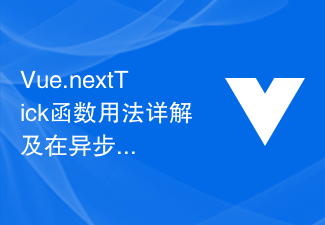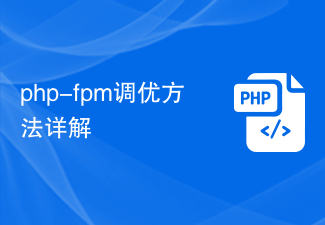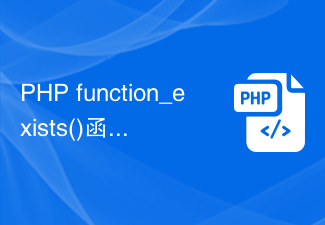This time I will bring you a detailed explanation of the use of the log component morgan. What are the precautions when using the log component morgan? The following is a practical case, let's take a look.
morgan is express's default log middleware. This article mainly introduces the method of express's default log component morgan. The editor thinks it is quite good. Now I will share it with you and give it as a reference. Let’s follow the editor and take a look.
Chapter Overview
morgan is express’s default log middleware. It can also be separated from express and used as a node. The .js log component is used alone. This article goes from shallow to deep, and the content mainly includes:
Getting started with morgan examples
How to save logs to local files
Core API usage instructions and examples
Advanced usage: 1. Log splitting 2. Write logs to database
Source code analysis: Morgan’s log format and pre-compilation
##Getting started example
First ,Initialization project.
npm install express morganThen, add the following code in basic.js.
var express = require('express');
var app = express();
var morgan = require('morgan');
app.use(morgan('short'));
app.use(function(req, res, next){
res.send('ok');
});
app.listen(3000);
node basic.jsRun the program and access http://127.0.0.1:3000 in the browser. The print log is as follows
➜ 2016.12 .11-advanced-morgan git:(master) ✗ node basic.js::ffff:127.0.0.1 - GET / HTTP/1.1 304 - - 3.019 ms
::ffff:127.0.0.1 - GET / favicon.ico HTTP/1.1 200 2 - 0.984 ms
Print the log to a local file
#morgan supports the stream configuration item, which can be used to implement The effect of log implementation, the code is as follows:var express = require('express');
var app = express();
var morgan = require('morgan');
var fs = require('fs');
var path = require('path');
var accessLogStream = fs.createWriteStream(path.join(dirname, 'access.log'), {flags: 'a'});
app.use(morgan('short', {stream: accessLogStream}));
app.use(function(req, res, next){
res.send('ok');
});
app.listen(3000);
Usage explanation
Core APImorgan has very few APIs, and the most frequently used one is morgan( ), its function is to return an express log middleware.morgan(format, options)The parameter description is as follows:
- format: Optional, morgan has defined several log formats, each format has a corresponding name, such as combined, short etc. The default is default. The differences between different formats can be found here. The following will explain how to customize the log format.
- options: Optional, configuration items, including stream (commonly used), skip, and immediate.
- stream: Log output stream configuration, the default is process.stdout.
- skip: Whether to skip logging, please refer to here for usage.
- immediate: Boolean value, default is false. When true, the log will be logged as soon as the request is received; if false, the log will be logged after the request returns.
Customized log format
First understand the two concepts in morgan: format and token. Very simple:- format: log format, which is essentially a string representing the log format, such as :method :url :status :res[content-length] - :response-time ms.
- Token: The component of format, such as :method and :url above are so-called tokens.
morgan.format(name, format); // 自定义日志格式 morgan.token(name, fn); // 自定义token
Custom format
is very simple, first define the log format named joke through morgan.format(), and then call it through morgan('joke') Can.var express = require('express');
var app = express();
var morgan = require('morgan');
morgan.format('joke', '[joke] :method :url :status');
app.use(morgan('joke'));
app.use(function(req, res, next){
res.send('ok');
});
app.listen(3000);Let’s take a look at the running results
➜ 2016.12.11-advanced-morgan git:(master) ✗ node morgan.format.js[joke] GET / 304
[joke] GET /favicon.ico 200
Custom token
The code is as follows, customize the token through morgan.token(), Then add the custom token to the custom format.var express = require('express');
var app = express();
var morgan = require('morgan');
// 自定义token
morgan.token('from', function(req, res){
return req.query.from || '-';
});
// 自定义format,其中包含自定义的token
morgan.format('joke', '[joke] :method :url :status :from');
// 使用自定义的format
app.use(morgan('joke'));
app.use(function(req, res, next){
res.send('ok');
});
app.listen(3000);
运行程序,并在浏览器里先后访问 http://127.0.0.1:3000/hello?from=app 和 http://127.0.0.1:3000/hello?from=pc
➜ 2016.12.11-advanced-morgan git:(master) ✗ node morgan.token.js
[joke] GET /hello?from=app 200 app
[joke] GET /favicon.ico 304 -
[joke] GET /hello?from=pc 200 pc
[joke] GET /favicon.ico 304 -
高级使用
日志切割
一个线上应用,如果所有的日志都落地到同一个本地文件,时间久了,文件会变得非常大,既影响性能,又不便于查看。这时候,就需要用到日志分割了。
借助file-stream-rotator插件,可以轻松完成日志分割的工作。除了file-stream-rotator相关的配置代码,其余跟之前的例子差不多,这里不赘述。
var FileStreamRotator = require('file-stream-rotator')
var express = require('express')
var fs = require('fs')
var morgan = require('morgan')
var path = require('path')
var app = express()
var logDirectory = path.join(dirname, 'log')
// ensure log directory exists
fs.existsSync(logDirectory) || fs.mkdirSync(logDirectory)
// create a rotating write stream
var accessLogStream = FileStreamRotator.getStream({
date_format: 'YYYYMMDD',
filename: path.join(logDirectory, 'access-%DATE%.log'),
frequency: 'daily',
verbose: false
})
// setup the logger
app.use(morgan('combined', {stream: accessLogStream}))
app.get('/', function (req, res) {
res.send('hello, world!')
})
日志写入数据库
有的时候,我们会有这样的需求,将访问日志写入数据库。这种需求常见于需要实时查询统计的日志系统。
在morgan里该如何实现呢?从文档上,并没有看到适合的扩展接口。于是查阅了下morgan的源码,发现实现起来非常简单。
回顾下之前日志写入本地文件的例子,最关键的两行代码如下。通过stream指定日志的输出流。
var accessLogStream = fs.createWriteStream(path.join(dirname, 'access.log'), {flags: 'a'});
app.use(morgan('short', {stream: accessLogStream}));
在morgan内部,大致实现是这样的(简化后)。
// opt为配置文件 var stream = opts.stream || process.stdout; var logString = createLogString(); // 伪代码,根据format、token的定义,生成日志 stream.write(logString);
于是,可以用比较取巧的方式来实现目的:声明一个带write方法的对象,并作为stream配置传入。
var express = require('express');
var app = express();
var morgan = require('morgan');
// 带write方法的对象
var dbStream = {
write: function(line){
saveToDatabase(line); // 伪代码,保存到数据库
}
};
// 将 dbStream 作为 stream 配置项的值
app.use(morgan('short', {stream: dbStream}));
app.use(function(req, res, next){
res.send('ok');
});
app.listen(3000);
深入剖析
morgan的代码非常简洁,从设计上来说,morgan的生命周期包含:
token定义 --> 日志格式定义 -> 日志格式预编译 --> 请求达到/返回 --> 写日志
其中,token定义、日志格式定义前面已经讲到,这里就只讲下 日志格式预编译 的细节。
跟模板引擎预编译一样,日志格式预编译,也是为了提升性能。源码如下,最关键的代码就是compile(fmt)。
function getFormatFunction (name) {
// lookup format
var fmt = morgan[name] || name || morgan.default
// return compiled format
return typeof fmt !== 'function'
? compile(fmt)
: fmt
}
compile()方法的实现细节这里不赘述,着重看下compile(fmt)返回的内容:
var morgan = require('morgan');
var format = morgan['tiny'];
var fn = morgan.compile(format);
console.log(fn.toString());
运行上面程序,输出内容如下,其中tokens其实就是morgan。
function anonymous(tokens, req, res
/**/) {
return ""
+ (tokens["method"](req, res, undefined) || "-") + " "
+ (tokens["url"](req, res, undefined) || "-") + " "
+ (tokens["status"](req, res, undefined) || "-") + " "
+ (tokens["res"](req, res, "content-length") || "-") + " - "
+ (tokens["response-time"](req, res, undefined) || "-") + " ms";
}
看下morgan.token()的定义,就很清晰了
function token (name, fn) {
morgan[name] = fn
return this
}
相信看了本文案例你已经掌握了方法,更多精彩请关注php中文网其它相关文章!
推荐阅读:
The above is the detailed content of Detailed explanation of the use of log component morgan. For more information, please follow other related articles on the PHP Chinese website!
 C++中的众数函数详解Nov 18, 2023 pm 03:08 PM
C++中的众数函数详解Nov 18, 2023 pm 03:08 PMC++中的众数函数详解在统计学中,众数指的是一组数据中出现次数最多的数值。在C++语言中,我们可以通过编写一个众数函数来找到任意一组数据中的众数。众数函数的实现可以采用多种不同的方法,下面将详细介绍其中两种常用的方法。第一种方法是使用哈希表来统计每个数字出现的次数。首先,我们需要定义一个哈希表,将每个数字作为键,出现次数作为值。然后,对于给定的数据集,我们遍
 C++中的取余函数详解Nov 18, 2023 pm 02:41 PM
C++中的取余函数详解Nov 18, 2023 pm 02:41 PMC++中的取余函数详解在C++中,取余运算符(%)用于计算两个数相除的余数。它是一种二元运算符,其操作数可以是任何整数类型(包括char、short、int、long等),也可以是浮点数类型(如float、double)。取余运算符返回的结果与被除数的符号相同。例如,对于整数的取余运算,我们可以使用以下代码来实现:inta=10;intb=3;
 Vue.nextTick函数用法详解及在异步更新中的应用Jul 26, 2023 am 08:57 AM
Vue.nextTick函数用法详解及在异步更新中的应用Jul 26, 2023 am 08:57 AMVue.nextTick函数用法详解及在异步更新中的应用在Vue开发中,经常会遇到需要进行异步更新数据的情况,比如在修改DOM后需要立即更新数据或者在数据更新后需要立即进行相关操作。而Vue提供的.nextTick函数就是为了解决这类问题而出现的。本文就会详细介绍Vue.nextTick函数的用法,并结合代码示例来说明它在异步更新中的应用。一、Vue.nex
 Django框架中的缓存机制详解Jun 18, 2023 pm 01:14 PM
Django框架中的缓存机制详解Jun 18, 2023 pm 01:14 PM在Web应用程序中,缓存通常是用来优化性能的重要手段。Django作为一款著名的Web框架,自然也提供了完善的缓存机制来帮助开发者进一步提高应用程序的性能。本文将对Django框架中的缓存机制进行详解,包括缓存的使用场景、建议的缓存策略、缓存的实现方式和使用方法等方面。希望对Django开发者或对缓存机制感兴趣的读者有所帮助。一、缓存的使用场景缓存的使用场景
 php-fpm调优方法详解Jul 08, 2023 pm 04:31 PM
php-fpm调优方法详解Jul 08, 2023 pm 04:31 PMPHP-FPM是一种常用的PHP进程管理器,用于提供更好的PHP性能和稳定性。然而,在高负载环境下,PHP-FPM的默认配置可能无法满足需求,因此我们需要对其进行调优。本文将详细介绍PHP-FPM的调优方法,并给出一些代码示例。一、增加进程数默认情况下,PHP-FPM只启动少量的进程来处理请求。在高负载环境下,我们可以通过增加进程数来提高PHP-FPM的并发
 PHP function_exists()函数用法详解Jun 27, 2023 am 10:32 AM
PHP function_exists()函数用法详解Jun 27, 2023 am 10:32 AM在PHP开发中,有时我们需要判断某个函数是否可用,这时我们便可以使用function_exists()函数。本文将详细介绍function_exists()函数的用法。一、什么是function_exists()函数?function_exists()函数是PHP自带的一个内置函数,用于判断某个函数是否被定义。该函数返回一个布尔值,如果函数存在返回True,
 Gin框架的模板渲染功能详解Jun 22, 2023 pm 10:37 PM
Gin框架的模板渲染功能详解Jun 22, 2023 pm 10:37 PMGin框架是目前非常流行的Go语言Web框架之一。作为一个轻量级的框架,Gin提供了丰富的功能和灵活的架构,使得它在Web开发领域中备受欢迎。其中一个特别重要的功能是模板渲染。在本文中,我们将介绍Gin框架的模板渲染功能,并深入了解它的实现原理。一、Gin框架的模板渲染功能Gin框架使用了多种模板渲染引擎来构建Web应用程序。目前,它支持以下几种模板引擎:
 PHP中的ORM框架使用详解Jun 23, 2023 am 11:22 AM
PHP中的ORM框架使用详解Jun 23, 2023 am 11:22 AMORM(Object-RelationalMapping)框架是一种用于将面向对象编程语言中的对象模型与关系型数据库之间映射的技术。它使开发人员能够使用面向对象的方式操作数据库,而不需要直接操作SQL语言。在PHP开发领域中,ORM框架也得到了广泛的应用。本文将详细介绍PHP中的ORM框架使用方法。一、ORM框架的优点使用ORM框架有以下优点:1.提高开发


Hot AI Tools

Undresser.AI Undress
AI-powered app for creating realistic nude photos

AI Clothes Remover
Online AI tool for removing clothes from photos.

Undress AI Tool
Undress images for free

Clothoff.io
AI clothes remover

AI Hentai Generator
Generate AI Hentai for free.

Hot Article

Hot Tools

WebStorm Mac version
Useful JavaScript development tools

SAP NetWeaver Server Adapter for Eclipse
Integrate Eclipse with SAP NetWeaver application server.

MantisBT
Mantis is an easy-to-deploy web-based defect tracking tool designed to aid in product defect tracking. It requires PHP, MySQL and a web server. Check out our demo and hosting services.

SublimeText3 Chinese version
Chinese version, very easy to use

Dreamweaver Mac version
Visual web development tools






